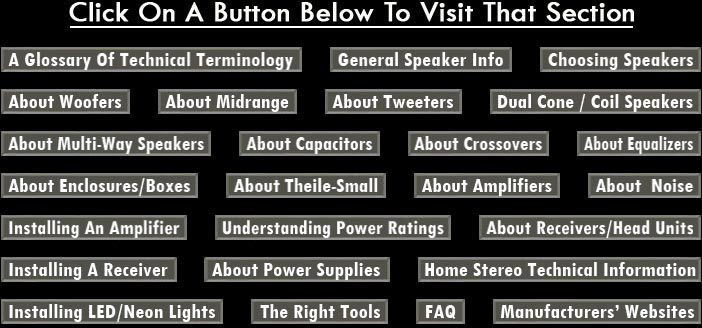


LCD
Liquid Crystal Display. Probably the most common way of showing visual information on non-computer electronic equipment.
L-Pad
A low resistance (commonly 8 ohms) potentiometer used primarily to control the input delivered to a speaker. A remote site volume control.
Le (Measured in millihenries, mH)
The electrical inductance of a speakeras voice coil.
Limiter
An electronic compressor with a fixed ratio of 10:1 or greater. The dynamic action effectively prevents the audio signal from becoming any larger than the threshold setting. For example, if the threshold is set for, say, +12 dBu and the input signal increases by 10 dB to +26 dB, the output only increases by 1 dB to +13 dBu, essentially remaining constant. Used primarily for preventing equipment overloads, thus reducing clipping distortion.
Line-level
Standard +4 dBu or -10 dBV audio levels. Used in communicating standard signals between processing devices, such as : receiver to equalizer, or equalizer to amplifier.
Linear
1)Referring to mechanical movement, the ability of the voice coil to move in and out in the air gap without moving side-to-side. Non-linear movement can damage the voice coil.
2) Referring to woofer response, the ability to maintain power or movement without loss of drive force.
3) Referring to enclosure port operation, the relationship bewteen the amount of air moving through the port vs. the amount of air moved by the cone. Non-linear response in a port can cause audible distortion.
Linear phase response
Any system which accurately preserves phase relationships between frequencies.
Linearity
The degree to which a given transducer or amplifier can produce an equal response within its specified range. This is usually measured in dB with +or - as small a number as possible indicating the least amount of variance from the desired flatness.
Listening Positio
n
A feature which can optimize frequency response and imaging for a particular position in a vehicle through the use of signal delay.1
Load
The resistance or impedance to which energy is being supplied. In amplifiers, the speaker or speakers connected to the output of the amplifier.4
Loss
The difference between potential energy output and actual energy output.
Lossy Compression
A type of data compression which permanently discards data that humans supposedly "cannot hear" to create much smaller audio, video and image file sizes. When the file is decompressed by the recipient, this compression method replaces the data for the sections it removed with calculated values to restore the file. The decompressed file is similar but not identical to the original file.
Loudness
The Sound Pressure Level of a standard sound which appears to be as loud as the unknown. Loudness level is measured in phons and equals the equivalent SPL in dB of the standard. [For example, a sound judged as loud as a 40 dB-SPL 1 kHz tone has a loudness level of 40 phons. Also, it takes 10 phons (an increase of 10 dB-SPL) to be judged twice as loud.]
Loudness Compensation
When played quietly, this switched circuit allows fuller apparent sound from a system such that the tendancy for human hearing sensitivity to drop off at certain frequencies is compensated and the full range is heard.
Loudspeaker
An electro-acoustic transducer that converts electrical audio signals at its input to audible sound waves at its output.
Low Frequency
Refers to radio frequencies within the 30-300 kHz band. In audio it usually refers to frequencies in the 20-160 Hz band.
Low Pass Filter
A network of components which attenuate all frequencies above a predetermined frequency selected by the designer. Frequencies below cut-off are passed without any effect.
Low Q
A low Q, or QTS, (reactance) woofer Driver is desirable for use in a vented enclosure.















